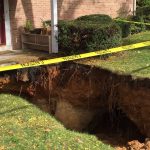Sinkhole damage claims are a vital aspect of property insurance, particularly in regions prone to geological instability. When sinkholes occur, they can cause significant damage to buildings, infrastructure, and surrounding land. Understanding the intricacies of sinkhole damage claims is crucial for property owners to navigate the insurance process effectively. This article provides an in-depth exploration of what sinkhole damage claims entail and how they operate within the realm of insurance coverage.
What is a Sinkhole Damage Claim?
A sinkhole damage claim is a request made by a property owner to their insurance provider for compensation to repair or replace property damaged by a sinkhole. Sinkholes are depressions or cavities in the ground caused by the collapse of surface layers, often due to the dissolution of underlying bedrock, typically limestone, by groundwater. When a sinkhole forms beneath a structure or in its vicinity, it can lead to structural damage, foundation issues, and other related problems.
How Do Sinkholes Form?
Understanding the formation of sinkholes is essential to grasp the nature of sinkhole damage claims fully. Sinkholes can develop gradually over time through natural processes or suddenly due to human activities such as groundwater pumping, construction, or heavy rainfall. Natural sinkholes often occur in areas with soluble bedrock, where water dissolves the rock over time, creating voids underground. When the overlying sediment can no longer support the weight, it collapses, resulting in a sinkhole.
Insurance Coverage for Sinkhole Damage
Insurance coverage for sinkhole damage varies depending on the type of policy and the geographic location of the insured property. In regions prone to sinkholes, such as Florida, insurers typically offer specific sinkhole coverage as an addendum to standard homeowners’ policies. This coverage may include damage to the structure, personal property, and additional living expenses incurred while the property is uninhabitable.
Filing a Sinkhole Damage Claim
The process of filing a sinkhole damage claim begins with documenting the damage and notifying the insurance company promptly. Insurers typically require detailed information about the extent of the damage, including photographs, repair estimates, and any relevant engineering reports. Once the claim is submitted, the insurance company will conduct an investigation to determine the cause and extent of the damage before approving or denying the claim.
Determining Coverage and Liability
Insurance companies may employ various methods to assess sinkhole damage claims, including geological surveys, soil testing, and structural inspections. If the insurer determines that the damage resulted from a covered peril, such as a sudden collapse, the claim is likely to be approved, and compensation will be provided according to the terms of the policy. However, disputes may arise if the insurer disputes the cause of the damage or alleges negligence on the part of the property owner.
Legal Considerations and Dispute Resolution
In cases where sinkhole damage claims are denied or disputed, property owners have legal recourse to challenge the insurer’s decision. This may involve engaging legal counsel, filing a complaint with the state insurance department, or pursuing litigation against the insurer for breach of contract or bad faith denial of coverage. Resolving sinkhole damage claims through legal channels can be complex and time-consuming, requiring expert knowledge of insurance law and relevant court precedents.
Conclusion
In conclusion, sinkhole damage claims are a critical aspect of property insurance for individuals and businesses located in sinkhole-prone regions. Understanding how sinkholes form, the insurance coverage available, and the process of filing a claim is essential for property owners to protect their interests and recover from sinkhole-related damage effectively. By familiarizing themselves with the intricacies of sinkhole damage claims, property owners can navigate the insurance process with confidence and secure the compensation they deserve.
FAQs
1. What causes sinkholes to form?
Sinkholes can form naturally due to the dissolution of soluble bedrock by groundwater or suddenly due to human activities such as construction or groundwater pumping.
2. Is sinkhole damage covered by standard homeowners’ insurance policies?
In regions prone to sinkholes, insurers may offer specific sinkhole coverage as an addendum to standard homeowners’ policies. It’s essential to review your policy to understand the extent of coverage.
3. How can I dispute a denied sinkhole damage claim?
If your sinkhole damage claim is denied or disputed by the insurer, you can seek legal recourse by engaging legal counsel, filing a complaint with the state insurance department, or pursuing litigation against the insurer.
4. What documentation do I need to file a sinkhole damage claim?
When filing a sinkhole damage claim, you will typically need to provide documentation such as photographs of the damage, repair estimates, and any relevant engineering reports to support your claim.










